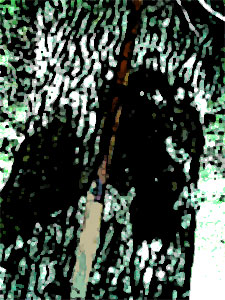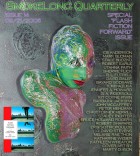Oliver had one store-bought bow when he was five or six. It came attached to a cardboard target with an Indian chief on it. After that, he always made his own. “To be an archer you got to be a bowyer first,” he’d say. He went out into the forest and looked for trees that would give him staves, which he sometimes referred to as “bow bone.” These staves had to be sapwood, i.e., the live bleeding wood that nourished the tree and made it grow. That’s what provided the bow with its fibrous resilience and toughness, its power and durability. Once he found and shaped his bow bone, Oliver built it up with strengthening laminates of the same wood or perhaps tropical hardwood, special ordered through the lumber mill. Or there was horn. Once upon a time, the Turks used horn, shaped and fitted in such a way that, allegedly, they could shoot an arrow a half mile. Oliver claimed one Turk held the distance record for a hundred years, not broken until well into the twentieth century by an archer with modern physics and material science on his side. There was no disputing Oliver’s “facts.” His facts were as strong as his bows. Only he could bend or twist them. When he launched a fact at you, the impact on the discussion was terminal.
He particularly liked the velvety touch of yew, but he also liked the mineral stains in hickory, which leeched the land upon which it stood and thereby streaked and mottled itself with cirrus clouds of earthly mist. Matt often thought Oliver’s brain must look like a piece of hickory. He called him “Old Hickory” once, after Andy Jackson. Oliver didn’t like that.
He was just a boy, but he had his Fred Bear books and sheets of graphing paper and a German pen with a steel nib for making notes and diagrams and all the right chisels and coping saws and vises and swatches of leather to grip the wood without damaging it. He also had an array of glues and solvents and a pedal lathe driven by a brown leather belt, and he knew all the names of a bow’s parts even though his bows (long bows in those days) came out looking unitary, organic, indecipherable. There were pivot points, lower and upper limbs, arrow rests and arrow plates, and tips at both ends, of course, but someone like Matt couldn’t see them. All he could see was what anyone saw: a bow, a beautiful, beautiful bow.
From one of his books, or by listening to some woodworker he met in North River—a grandfather or school teacher who turned to physical tasks for relief in the evenings—Oliver learned that “slower is faster.” Thereafter, in his personal algebra of labor, that was his formula. The more complex the project, the slower he worked; the slower he worked, the faster he found what he called the “simple points,” those myriad elementary steps which combine through time and imagination into complexity. When he couldn’t make a simple point any simpler, he knew where he was at, and that’s where, slowly and carefully, in a kind of pas de deux of hands and fingers, he made his move.
After finally finishing, he might come into Matt’s room with one of his new bows and tell him about it. The look he had on his face was always the same. He was like a cat bringing his master a mouse, depositing it on the doorstep and then looking up, as if to say, “There. That’s what you do. That’s how you hunt.”
“I got the wood in Axel’s back field. Don’t tell him,” he’d confide, running his words all together the way they apparently jumbled up in his mind. “This grip is more like my hands than my own skin.”
And he’d hold the bow by the grip, majorette-like, and indeed he’d seem to have made his hand disappear right into the wood.
He’d goof sometimes, of course. The perfection of wood, like the perfection of fire and water, inheres in its irregularity. The best bow billets came side by side within the same tree; even yet you could be fooled when matching up the grain of the upper and lower halves of the bow. Something could go wrong in the mating dance of the fishtail splice you fashioned.
“Not all wood is the same, one piece to another,” he’d explain. “Six inches along, it’s like you hit a bad year or two. Too much rain, too little. It can soften out, lose its rubber.” That was his word for flexibility or resilience: rubber. “But this bow’s got some deep hard rubber in it. Want to try it?”
With Oliver’s gentle instructions guiding him, Matt had a chance of lobbing a few heavy cedar arrows into the center of the target.
“Breathe when you nock it, and then forget everything you ever knew,” he’d instruct Matt. “Let the bow do the pushing, that’s what she wants.”
But the bigger Oliver got, the bigger his bows got, too big for Matt. Eventually he had a preference for draw weights others claimed to be in excess of seventy-five pounds, though he would never let his bows be measured any more than he would weigh his arrows to find out how many grains they were.
“You can know your bow, or you can know your numbers,” he’d say. It was all “six times six” to him, the truths of work, taxes, and boredom. Give in to one, you gave in to all. He wanted to escape from anything and everything the rest of the world said. And he was good at it. He really was.



 The SmokeLong Grand Micro Contest (The Mikey) is now an annual competition celebrating and compensating the best micro fiction and nonfiction online.
The SmokeLong Grand Micro Contest (The Mikey) is now an annual competition celebrating and compensating the best micro fiction and nonfiction online.